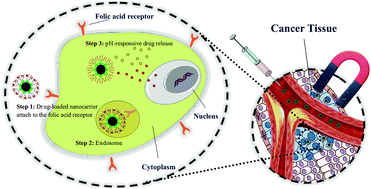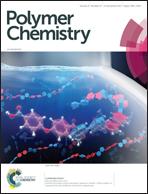Co-delivery of doxorubicin and methotrexate by dendritic chitosan-g-mPEG as a magnetic nanocarrier for multi-drug delivery in combination chemotherapy
Abstract
Nanoparticulate drug delivery systems have the potential to improve the therapeutic efficacy of anticancer agents, and combination therapy is a promising strategy for clinical cancer treatment with synergistic effects. The purpose of this report is to evaluate a smart, biocompatible, magnetic nanocarrier for the intracellular co-delivery of doxorubicin (DOX) and methotrexate (MTX) to the MCF7 cell line. Since dendritic architecture based nanoparticles can load high doses of drugs with various properties, we evaluated dendritic chitosan grafted mPEG coated magnetic nanoparticles (DPC@MNPs) as a magnetic nanocarrier that has potential in multi-drug delivery. DPC@MNPs with high encapsulation efficiencies of 95.96% for DOX and 67.91% for MTX, has shown controlled and pH-dependent behaviour with tumor target release. After confirmation of the nanocarrier biocompatibility with human red blood cells by hemolysis assay, SDS-PAGE assay was performed to simulate how the nanocarrier interacts with proteins that exist in the blood circulation systems. The results show that several proteins in human blood plasma could attach to the nanocarrier surface and provide the nanocarrier with stealth properties that are suitable for drug delivery systems. An in vitro study of cell viability showed that combination drug delivery has synergistic effects and reduces toxic side effects. Furthermore, the cytotoxicity assay of the nanocarrier to the MCF7 cell line indicated that DPC@MNPs is suitable as an anticancer drug nanocarrier. Dual-drug delivery with efficient anticancer performance was also confirmed by DAPI staining, cellular uptake, cell cycle, and apoptosis analysis, compared to free dual anticancer drugs. To assess the healthy, apoptotic, and necrotic cells, DAPI staining and apoptosis analysis by flow-cytometry were conducted and all data showed that the apoptotic effects of the drug-loaded nanocarrier are higher in comparison to the corresponding free drugs. Cellular uptake was also examined to validate the internalization of the nanocarrier in the cells and the results have shown that a high uptake percentage was observed within 3 h. Finally, the side effects of the drug-loaded nanocarrier and free drugs were assessed using the mouse model and it was concluded that this combination therapy offers a promising approach to cancer treatment and can be used for further in vivo applications.



 Please wait while we load your content...
Please wait while we load your content...